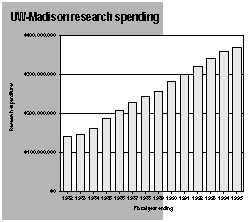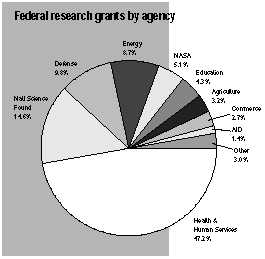- Q&A (continued)
Three schools - the Medical School, Letters & Sciences and the Graduate School - received more than two-thirds of the research grant money awarded to UW-Madison in 1994-95. (see graph, facing page)
What departments receive the most grant money for research?
The department that received the most research grant money was the Engineering Experimen-tal Station, which received more than $33 million. The departments of physics and medicine were the next largest grant winners, receiving more than $16 million each.
Do all areas of the university receive grant money?
The bulk of funding for research is awarded to projects in the biological or physical sciences, but studies in the social sciences and humanities also win research funding. Of federal money granted for research, 43 percent was awarded to projects in the biological sciences, 46 percent was awarded to projects in the physical sciences, and 11 percent was awarded to projects in the social sciences. Of research grant money from nonfederal sources, 54 percent of grants went to biological sciences, 27 percent went to physical sciences, 17 percent went to social sciences, and 2 percent went to humanities.

How much money is awarded in a typical grant?
Research grant awards can range from very small - less than $10,000 - to very large - $1 million or more. In 1994-95, 66 faculty members received grants of $1 million or more, but the average grant was much smaller. In particular, nonfederal research grants tend to be small; 31 percent of nonfederal grants received by UW-Madison in 1994-95 carried awards of less than $10,000. Federal research grants, on the other hand, can be quite large: 69 percent of federal grants awarded to UW-Madison in 1994-95 were for more than $100,000. The largest grant received by a UW-Madison researcher in that time was a federal grant worth $11.5 million.
How much has UW-Madison's research enterprise grown in recent years?
In 1984-85, UW-Madison spent $187 million on research projects. Ten years later, the amount of money UW-Madison spends on research has nearly doubled, accounting for more than $369 million in 1994-95. (see graph, above)
Has funding for research remained stable over recent years?
Between 1989-90 and 1994-95, awards for research increased by 10 percent a year. In 1995-96, funding dropped significantly. From 1989-90 to 1994-95, federal awards for research increased by more than 13 percent a year, while nonfederal research awards increased by 4 percent per year; both sources have been suspectible to annual fluctuations.
UW-Madison's office of University-Industry Relations acts as a matchmaker between researchers and business, finding industry partners for faculty researchers, and vice versa. Researchers also maintain close connections with industry and community through collaborative research projects and participation on numerous boards and committees. Currently, faculty are serving as members of 18 industrial consortia. UW-Madison also plays a role in helping companies using university research get started in business. More than 60 compa-nies can trace their roots to UW-Madison; many have started as a direct result of patented UW-Madison advances. At the UW's 700,000-square-foot University Research Park, 63 companies, employing 1,800, benefit from UW-Madison collaboration.

How much income does UW-Madison get from the application of research?
The Wisconsin Alumni Research Foundation has obtained more than 800 U.S. patents for UW-Madison work since 1925. The applications of those patents have brought more than $342 million to the university over that time. In 1995, WARF received more than $12 million from UW-Madison patents, making it the country's fifth largest producer of patent income. The income received by WARF is rechanneled into UW-Madison research following federal guidelines.

How do students participate in university research?
Among the most valuable returns of UW-Madison research is its contribution to the university's teach-ing mission. Undergradu-ate, graduate and profes-sional students reap benefits from faculty research through better-informed classroom and laboratory presentations. UW-Madison also devotes significant resources to fostering student involve-ment with research. The Hilldale Fellowship program, for example, enables approximately 100 undergraduate students each year to work with faculty on a research project of their own design. Some 2,300 students participate as research assistants, working directly with faculty as members of research teams in order to fulfill graduate-degree requirements.

